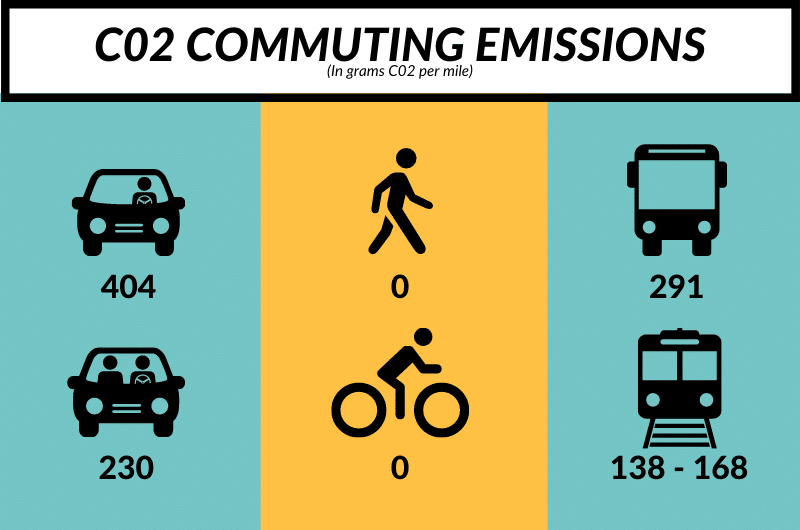Cycling is great for the body and the mind. Not only is it healthy and fun, but it can also sometimes be the quickest way to travel. When commuting to work in the city, cycling saved me many painful hours of sitting in a car or on a bus, inching along on clogged-up roads.
But one of the best things about cycling is that it’s eco-friendly. Those who cycle regularly can take pride in doing their bit for the environment, at least in the travelling sense. I’ve had many a warm, smug glow whilst whizzing past lines of smelly, congested traffic on my way to work.
But was my smugness entirely justified? Is cycling really as green as we think it is? Digging a little deeper, it may not be as black and white (or green) as we think. We’re going to take a look at how environmentally-friendly cycling actually is.
Is Cycling Really Green?
Cycling as an activity, whether for commuting or leisure, is as green as it gets. Using pedal power emits virtually no harmful emissions or toxins into the environment. But the production of bicycles is a different story and yes, this does have a carbon footprint.
Although the manufacture of a bicycle has a far lower carbon footprint than the manufacture of a car, it is still an issue. Cycling as an industry has a long way to go before it can claim to be entirely green.

Are Bikes Bad for the Environment?
If we focus on bikes as ‘objects’, their environmental impact is very low compared to cars. In fact, the manufacture of a small car emits approximately 55 times as many CO2 emissions as that of an average bicycle.
However, the materials used for bikes, such as aluminium, steel, rubber, and carbon, have a negative environmental impact in terms of how they’re acquired, treated and transported. Many bike parts, including frames, are shipped or flown from overseas, using fossil fuels to do so.
That said, once riding the bike, you’re at least playing a part in offsetting the environmental impact of its manufacture. Studies have shown that even small increases in cycling trips (substituted for car trips) can have a huge impact on decreasing harmful emissions.
Bicycle Pollution
Aside from bike manufacture, cycling is a non-polluting mode of transport. It reduces air as well as noise pollution. In terms of old bikes, it is possible to recycle some bike parts. However many (of the estimated 15 million) discarded bikes each year, still end up in landfill.
This is something of a tragedy, as it simply doesn’t have to be the case. Recycling bike parts is often possible. There are numerous charities willing to take old bikes, even in poor condition. Many of these charities repair the bikes, or use them for parts, to help people in need.
However, some bike parts and accessories, such as cycle helmets, are difficult to recycle and end up as waste. This can be reduced if cyclists opt for eco-friendly options. These are becoming more widely available as manufacturers respond to the climate emergency.
Polluting accessories such as bike cleaners, notoriously loaded with harmful organic solvents, can be easily replaced with effective eco-friendly cleaning products.

Is Cycling Bad for the Environment?
As a form of transport, cycling is not bad for the environment. Certainly not when compared to motorised transport! Per kilometre, cycling has a carbon footprint of around 20g of CO2. This is less than a tenth of the emissions produced by a car over the same distance.
How is Riding a Bicycle Environmentally-Friendly?
Even if we consider the carbon footprint of a bike’s lifecycle, cycling is still an eco-friendly activity when compared to other ways of travelling. When riding a bike we’re not burning non-renewable fuels. We’re not polluting the air or the environment, and we’re easing congestion.
Studies show that transportation is now the biggest cause of pollution in the UK, with passenger cars being the largest contributor. Research has suggested that if 10% of the population made more journeys by bike, emissions from cars would be reduced by around 4%.
Why is Cycling Good for the Environment?
Cycling is clean and it’s quiet. If you’ve cycled alongside traffic in a city, you’ll have experienced the pollution, the noise, the smell and the heat. During the Covid 19 lockdowns, global CO2 emissions dropped by 6.4%. Less car use and more bike use certainly contributed to this.
Not that anyone would want another pandemic to dominate our lives. But I remember avidly following a friend’s Facebook page as she posted daily photographs of her traffic-free cycle rides in London. In spite of everything else going on, she described them as ‘joyful’.
It’s food for thought – clean cities dominated by two wheels instead of four.

Environmental Benefits of Cycling
As cycling increases, so does the demand for the development of traffic-free spaces. More people cycling results in less concrete and more plants and wildlife in urban areas, along with the reduction of harmful emissions.
And when we talk about our environment and transport, we rarely consider animals. But ask yourself when was the last time that you killed a pigeon or a rabbit whilst riding a bike? The answer, probably, is that you never have.
Cars vs Bike Emissions
In terms of its manufacture, a car is responsible for roughly 65g of CO2 emissions per mile driven. Adding these to emissions while driving takes it up (on average) to around 280g per mile. In contrast, the carbon footprint of cycling per mile (from manufacture and use) is around 33g of CO2.
The carbon footprint of cycling isn’t all from the manufacturing process alone, it’s also measured in how we fuel cycling, and therefore the food that we eat. What we eat and where it comes from has a huge impact on how many grams of CO2 we emit daily.
For example, if your cycling is powered by locally-grown vegetables, your human CO2 emissions will be considerably less than if powered by cheeseburgers.
Some might argue that cycling is active, and therefore we eat more to fuel it, but unless you’re absolutely caning it on an epic daily commute or training schedule, this will not be the case for most people.

Carbon Emissions Saved by Cycling Calculator
This amazing tool will show you exactly how many carbon emissions you’re saving on your bike journey, compared to driving (different types of) cars, and give you an idea of just how environmentally-friendly cycling is.
How Much Does Riding a BIke Reduce Your Carbon Footprint?
Even taking into account the manufacturing process, the food that we eat and the energy used to recycle, riding a bike (as opposed to driving a car) undoubtedly lowers our carbon footprint. On average, the carbon footprint of cycling is approximately one tenth that of driving.
In a first of its kind, Trek released a sustainability report in 2021 that laid out the exact numbers of CO2e (carbon dioxide equivalent) emissions in the production of its bikes.
The figures range from 116kg to 223kg CO2 emissions in a representative selection of bikes. The 223kg represented the Rail e-bike. E-bikes add over 60kg to emissions in manufacture, but in use have a lower carbon footprint because less calories are burned.
How Much CO2 Does Cycling Save?
Cycling saves at least 90% of CO2 emissions compared to driving. And the good news is that after you’ve ridden your bike for 430 miles (instead of driving those miles), you will have saved as many CO2 emissions as it took to produce the bike in the first place.
This is according to Trek’s sustainability report, which claims: “The carbon cost of manufacturing a bike can be mitigated or entirely offset when it’s used to its potential.”

How Much Can Bicycles Help Fight Climate Change?
CO2 emissions are the biggest contributor to climate change. In the UK, by 2019, greenhouse gas emissions dropped by about 40% from levels in the 1990s. During the pandemic, between 2019 and 2020, household emissions (including personal transport) fell by around 15 million tons of CO2e.
Cycling will have contributed to this in part. The pandemic bike boom gave us a taste of what our streets could look like. But unfortunately, as the Covid 19 crisis wanes, so the environmental crisis increases.
There is still a long way to go in the UK and globally before we reach the 78% reduction target of greenhouse gases by 2035.
Changes in transportation, industry and lifestyle habits will be necessary in order to achieve this. It would be simplistic to say that cycling can save the planet. However, it can certainly be part of the solution.
The post Is Cycling Really Green? [The Pros + Cons of Bikes for the Environment] appeared first on Discerning Cyclist.
![Is Cycling Really Green? [The Pros + Cons of Bikes for the Environment]](https://bicycle.org/wp-content/uploads/2022/04/green-cycle-path-760x504.png)
